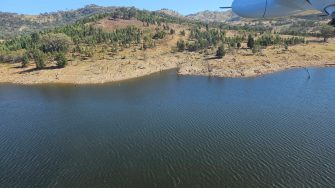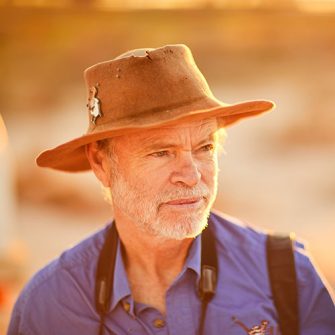
Date: Monday October 23rd 2023
Project: Eastern Australian Waterbird Survey
Observers: Richard Kingsford (UNSW), Heath Dunstan (Vic GMA)
Trainee: Kurt Murphy (Vic GMA)
Pilot: Thomas Clark
Today was my first leg of this 41st aerial survey of waterbirds. I was keen to see where the water was and whether the numbers of waterbirds had built up after La Niña years. Survey Band 4 starts west of the Great Dividing Range and we reached it after we flew over the Blue Mountains.
On our way over the mountains to pick up the wetlands west of the Great Dividing Range
Our first survey was over Burrendong Dam, at 84% capacity. As predicted these large dams support very few waterbirds, particularly when there is a lot of natural habitat around. Today was no different with only a few pelicans and cormorants on Burrendong Dam.
We then went down the Macquarie River towards Dubbo to refuel. After a quick bite to eat, we headed towards Menindee Lakes. Last year along this part of the world, there were lots of small dams and swamps with water. What a difference a year makes. Most of the dams were half empty and there were very few temporary swamps with water. There were a few birds here and there, but not so much habitat.
Surveying a dam and creek just west of Dubbo.
It was great to see the Tallyawalka Creek system, a major tributary of the Darling/Baaka River, had filled its overflow lakes. They are great shallow string of habitat with lots of Grey Teal, Freckled Duck and Black Duck. Cormorants and pelicans were also there in big numbers. This is a great system when it has water which only fills in major floods. But it still wasn't a big enough flood to inundate all of these great large lakes. If they don't fill with that size flood it's hard to see when they will next fill.
Surveying the Tallyawalka Creek overflow lakes
Then on to Menindee Lakes. We needed a break, so we briefly landed before heading to survey the lakes north of Menindee.
There were a few thousand pelicans, egrets and cormorants but the ducks were only in low numbers. There are obviously a lot of fish still in the Menindee Lakes, despite the catastrophic fish kills.
Lake Bijijie one of the large freshwater lakes in the Menindee Lakes system
Big flocks of cormorants and pelicans as well as egrets and herons dominated the freshwater lakes north of the town of Menindee.
This system remains a controversial focus for the Murray-Darling Basin Plan. Last year we criticised the lack of rigour in analysis of options that would severely impact the Menindee Lakes environment: a clear case of robbing Peter to pay Paul (see links in this press release). In our analysis we also found a long-term decline in waterbird numbers, mainly because these lakes aren’t filling as much as they used to because the Darling/Baaka River has seen a major reduction in its flow.
The dam created by Main Weir that crosses the Darling River allows water to be diverted and stored in the large lakes, primarily for the River Murray and also downstream.
We finished about 5pm after a long day.

